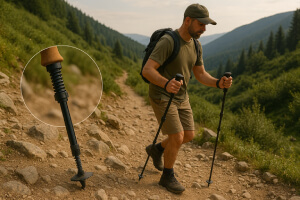Too often the little remark about choosing the right hiking poles is what makes all the difference in comfort, stability, and endurance while on the trail. Too many styles, materials, and features for one simple choice can seem an insurmountable task. Properly selected poles enable good balance, reduce strain on joints, and adapt to how one walks and the terrain.
Hiking poles are an extremely flexible tool, and they can be used to gain stability on ascent, for example, or to put less strain on the knees when on a descent, or simply to encourage good posture. The selection of the right pair should involve analyzing your needs, understanding the materials in the construction of the poles, the mechanism for adjustments, and therefore choosing the proper accessories.
Types of Hiking Poles
There are different types of hiking poles, each catering to different styles of hiking and terrains; the decision on which type to get is dependent on how they will be put to use.

Fixed-Length Poles
These plain poles are strong and sturdy, for day hiking on moderate terrain. They do not require adjustment, thus serve better in this regard. Ground that varies a lot or situations that call for different user heights require something more adaptable.
Adjustable Poles
Those poles are more versatile than fixed poles since the length can be changed depending on the terrain or user requirements. Telescoping poles can collapse to become shorter and more apt for storage and travel. Internal locking mechanisms generally enjoy a higher rate of reliability over external clamps, even if both do operate well when appropriately used.
Folding Poles
They are compact and lightweight, ideal for the backpacker or traveler. They fold into three sections for easy storage, though this flexible design generally might be a bit less sturdy under extreme load-the convenience, however, is worth it for a multi-day trek.
Choosing the Right Material
Material choice will determine the weight, strength, and price of hiking poles. Knowing these differences will put you in a good position to better match a pole to the hiking style and budget.
Aluminum
Material choice will determine the weight, strength, and price of hiking poles. Knowing these differences will put you in a good position to better match a pole to the hiking style and budget.
Carbon Fiber
Carbon-fiber poles weigh less and, thus, are the type of poles for long hikes or ultralight preferences. They are slightly more fragile under extreme stresses, heavy impacts, or twisting, so they need gentle handling.
Composite Materials
Some poles use aluminum and carbon fiber to strike a balance between weight, strength, and cost. In fact, all the hybrid poles are in between hard and comforting and are more general-use-type poles for hiking.
Pole Grip Options
The handle or grip is very important for selecting comfort and control. Different materials suit differing needs and conditions.
Cork
Cork grips mold to the user’s hands over time and resist moisture created by sweat. They are comfortable on long hikes and allow a very natural feel to the hand.
Foam
Foam grips are very thin but are capable of moisture absorption, and in hot or wet conditions, give comfort to one’s hands. Foam grips are more suited to the hot weather but do not wear as quickly as cork.
Rubber
Rubber grips are durable and provide excellent grip in cold or wet conditions. However, they tend to induce sweating in warm weather. Thus, they are considered synonymous with trekking in cold regions or downhill hikes.
Choosing the Right Length
The correct length directly affects one’s balance and efficiency. Incorrect lengths may instead cause discomfort or strain.
- On Flat Ground: Elbows should be at a 90 degree angle when holding onto the poles.
- Uphill: Lightly shorten poles to balance without leaning too far ahead.
- Downhill: Lightly lengthen poles to stop leaning ahead too far and to relieve knee strain.
Adjustable pole lengths are easy to change by yourself, depending on terrain and comfort.
Tips for Weight and Shock Absorption

Some are equipped with shock absorbers, often internal springs, which lessen the pressure on the wrist and elbow while going down a trail all long. Such a contraption, however, adds weight and cost and may be a positive for the hiker suffering from joint concerns.
Lighter poles make you less tired, whereas heavier poles can tire your arms faster but are stronger. The choice is always a compromise amongst weight, strength, and personal comfort.
Accessories and Extras
Many other accessories are available for hiking poles to increase their performance in particular conditions.
- Baskets: Prevent poles from sinking into mud or snow. Large winter baskets are a must for snow hiking.
- Tips: Carbide and rubber tips provide traction on rock, dirt, or pavement. Rubber tips help to reduce noise and wear when hiking on hard surfaces.
- Wrist Straps: Properly adjusted wrist straps increase stability and decrease hand fatigue.
The more easily you can interchange pole accessories, the more versatile and longer lasting your poles will be.
How to Test Hiking Poles

Given a choice, trying on poles can save a lot of grief later on. Hold them while walking on diverse terrain; do they feel balanced, comfortable, and supportive? Adjust the length of the poles; try different grips or materials on them. Also, factor in how heavy your pack is while conducting the test; this can make the test more realistic.
Going to a store where you can try the poles or maybe borrowing a friend’s set will do wonders for giving you a good sense of the weight on your hands, comfort of grips, and ease of adjustment. Comfort takes precedence on the long run; what feels a bit uncomfortable today might very soon be the reason for headaches, fatigue, or pain on longer hikes.
Find Your Ideal Poles
Hiking pole selection involves choices based on the type and material of the poles, the grips, length, and any improvements or accessories thereto. Ideally, the poles should grant some added stability to your walking process, thereby lowering pressure on your joints and making your hiking faster. Testing poles removed from comfort ensures their efficiency. Ensure their comfort with respect to your particular hiking style and terrain. Hiking poles, if chosen well, are sturdy, versatile, and well maintained to provide hikers with safer, comfortable, and more efficient time-outs into the outdoors.
